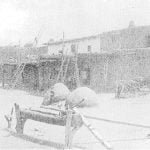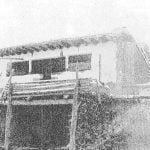
One approaches Tesuque, situated on the left bank of the river of that name, over a road winding through small orchards fenced by an abatis of cedar boughs driven into the ground, while apple and peach trees tangle their branches overhead. Small patches of wheat and corn lie on either side of the road. The village is built about a quadrangle 240 feet long by 150 feet broad. The houses are mostly of 2 stories. The Catholic Church is small and in a neglected condition. Methods of farming are crude. Both wooden and steel plows are used. Corn is planted too closely, seldom in rows. The result is fair. There is more uniformity in the size of the farms than at any other pueblo. The greatest amount of land owned by one person is 18 acres, the lowest 6 acres, an average of 9.3 acres. Orchards of an acre contain about 20 trees, yielding liberally. The fruit, however, is small and of little flavor. That found in the pueblos farther south is invariably fine. From 14 acres the owner has realized $110; from 10 acres, $65. Out of a population of 91, 25 maintain farms, cultivating 230 acres.
Pottery is an industry in this village. Proximity to Santa Fe supplies their kilns with orders. The products are usually fanciful and not characteristic of the Indian design. They still grind corn by stone rubbing. Four bins, each supplied with a stone fitted into it like a washboard, are found in many houses. The grain thrown first into the bin having the stone of roughest surface is there broken by bearing down upon it with a stone similar in shape to a “twist” loaf of bread, using the Motion of washing clothes, In the next bin, over a smoother surface of stone, the grain is ground a degree finer. After passing over 4 stones of graded surface the product is ready for sifting. Passable flour and corn meal are thus produced. Much of the raw material is exchanged for necessaries at Santa Fe.

The rooms of the houses, usually of small size, contain an occasional chair or table. A painted door is observed here and there. The walls are decorated with broad bands of yellow ocher or red clay to a height of 3 feet and above this to the rafters are whitened with gypsum. Occasionally the wash has been applied to the exteriors of the houses. Large porticoes, or atria, the pillars decorated by flat wooden capitals engraved in shallow design, are found upon the ground floor or second story. Glass is used in most of the windows, unfortunately preventing ventilation. The men wear overalls and vests, but hats never.
Tesuque has km grant of 17,471 acres.
